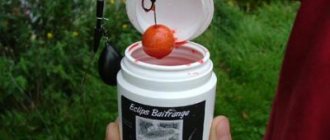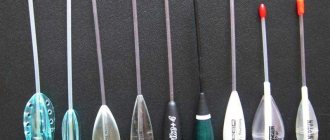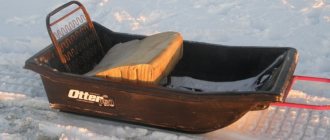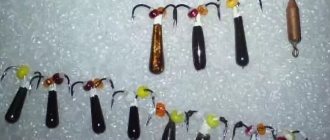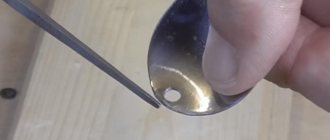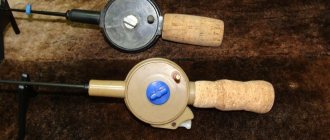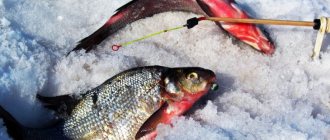What is a boat
This tackle is simple and complex at the same time. It consists of the boat itself, a fishing line with attached leashes with baits, and a reel on which this fishing line is wound. There are several ways to construct a water kite. Let's look at one of them in more detail - a catamaran boat. This option is the most traditional for the Urals. This option is preferable to others in that it is more stable and does not float on the water, as a result of which its use is also possible in standing water.
By its design, the boat consists of a sail and a hull, located at a distance of about 20 cm from each other. The fishing line is attached to the hull, and leashes with baits are already attached to it. To avoid such troubles as tangling of leashes, they are tied through special spacers made of suitable material. They are fixed on the fishing line with knots. The leading line should have a diameter of 0.5 mm, while the leads should be knitted with a soft line with a diameter of approximately 0.10 mm.
Often the number of leashes with baits is 4-6 pieces, but other options are possible. The distance between the leads should be 70-100 cm. You can make the reel yourself by cutting it out of thick wood or plywood. You can also use the lower leg of an old spinning rod. This will give the fisherman a slight advantage if fishing is carried out from a high bank and access to the water itself is difficult.
Simple manufacturing method
You need to make a boat for fishing in the likeness of a catamaran with cans of excellent size. Wooden blanks are marked according to trapezoidal templates. To compare the dimensions of a medium-sized boat, let’s start from the size of the larger can (the first length, the second width) 350x120 mm, and the smaller one 300x90 mm. The sharper the angle of the part, the steeper and faster the speed of the structure increases, but its control parameters deteriorate. After cutting the workpieces with a jigsaw, the sharp corners are smoothed to smooth shapes, and the side surfaces and ends are polished, which will give the catamaran greater streamlining.
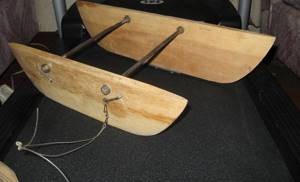
The polished parts are marked for installation of transverse fasteners, the length of which varies between 13–18 centimeters, and holes are drilled. A small can has a hole for a fastening hook in the center of the outer surface. In this form, the pieces of wood are treated with an impregnating composition and, after drying, they are painted using the method described above in two different colors. Metal studs are cut to a certain size for the width of the boat and their ends are trimmed to allow the workpieces to be screwed together. The painted wooden parts are connected along the drilled holes by tightening the studs, without fail installing spacer washers on the studs before tightening, to prevent damage and crushing of the wood.
Important! To prevent the connection from unwinding, nuts are placed from the inside and outside, and the screwing must be additionally tightened.
A hook is installed in the fastening hole, which is made from a pin and a pair of clamping nuts. To ensure the stability of the catamaran, increase its submerged mass, and therefore increase the parameters that contribute to the quality of control, the keel of the larger can is loaded with a lead plate. The plate is cut to the shape of a wooden blank and mounted, pressing it to the surface with self-tapping screws. To achieve stability, in some cases they resort to loading a small can, carrying out an operation similar to the one described above. Upon completion of loading, the do-it-yourself fishing boat is basically ready. Now all that remains is to test and adjust the stroke by adjusting the load and the fastening element.
Important! On a pond, adjustments are made on a cord similar to what will be used for fishing, performing all the adjustment operations.
Having achieved the required result of the vessel’s hull settling into the water and ease of control of the progress, the product is equipped with elements of a fishing rig and full-fledged fishing begins. Testing a bait boat with your own hands will require debugging the running mechanism at speed, practically determining the amount of idle speed when braking at different speeds, and checking the operation of the mixture release, which can be imitated by ordinary river sand.
Lures for grayling
When fishing with a boat, dry flies are mainly used, but you can try jigs, small spoons, and other small baits. In other words, you can use any bait that in your opinion is most suitable for the object being fished. After all, with a boat you can catch not only grayling, but also many other fish - asp, chub, even perch are excellently caught with this tackle. Many grayling fishermen prefer to use dry flies, the size and color of which imitate the insects on which the fish are currently feeding. For example, in summer they most often have a greenish tint, but closer to autumn they are brown or dark yellow.
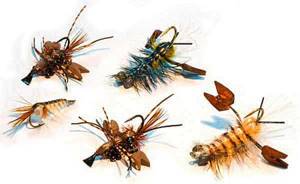
Fishing using a boat - the essence of the method
When fishing using structure, various baits are used, such as grasshoppers, flies, saran and the like. The tackle is launched into the water and upon departure the line gradually unwinds. To avoid tangling, the distance between wires must be at least 1 m.
In places where fish accumulate, lines are made with bait in the air. When the bait barely touches the water, the fish attacks the likely prey and is hooked. Next, you should carefully pull up the catch and catch it with a landing net.
Pros and cons of the gear:
- lightness, ease of transportation;
- Can be used for any fish;
- provide excellent fishing in all bodies of water where there is a current;
- Fishing on a boat is considered an almost fail-safe option. The only drawback is the high probability of falling in strong currents. However, this problem can be resolved by using special stabilizers attached to the board.
In the warm season on Lake Baikal they fish with riding gear using dry flies. The gear is selected a little larger than for the river and cast further.
It is best to go fishing with a boat in the early morning or late evening. Favorable weather is considered to be light winds creating ripples on the water, or cloudy conditions with moderate rain.
Where and when to catch grayling
When fishing for grayling on a boat, it is recommended to fish in reservoirs with an open bank, because After all, this is a popular type of fishing. Therefore, the fisherman should have the opportunity to move freely along the shore. It is recommended to start the fishing process at dawn and continue until the sun is high and the shadow from the fishing line stands out sharply on the water, because this scares the fish away.
You can also fish in the evening, until sunset. It’s very good if the day turns out to be cloudy - in this case you can fish almost all day. Fishing for grayling on a boat begins around mid-June. At this time, insects begin to fall into the water. Grayling fishing continues for quite a long period, right up to the first snowfalls.
3 ways to improve your fish bite!

Over 15 years of active fishing, I have found many ways to improve the bite, and here are the most effective:
1. Bite activator . This pheromone additive attracts fish most strongly in cold and warm water. The Fish Hungry bite activator has proven itself to be excellent - Read more…
2. Tackle with increased sensitivity . You should first familiarize yourself with the features of using a particular type.
3. Pheromone baits . They attract the attention of fish, stimulate hunger and cause a schooling reflex, which allows you to collect a lot of fish in one place.
You can get the rest of the secrets of successful fishing for free by reading my other materials on the site.
3 ways to improve your fish bite!
Over 15 years of active fishing, I have found many ways to improve the bite, and here are the most effective:
1. Bite activator . This pheromone additive attracts fish most strongly in cold and warm water. The Fish Hungry bite activator has proven itself to be excellent - Read more…
2. Tackle with increased sensitivity . You should first familiarize yourself with the features of using a particular type.
3. Pheromone baits . They attract the attention of fish, stimulate hunger and cause a schooling reflex, which allows you to collect a lot of fish in one place.
You can get the rest of the secrets of successful fishing for free by reading my other materials on the site.
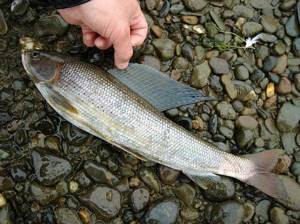
Technique for catching grayling on a boat
When fishing in a strong current, the boat is launched from the shore, not far from a riffle, where the current is quite strong. Gradually unwinding the fishing line from the reel, the boat is released in the direction of the expected location of the fish. Moving along the shore, by pulling the fishing line, the fisherman directs the boat with the current, lowers it down, loosening the tension of the fishing line, or simply holds the boat in a promising area.
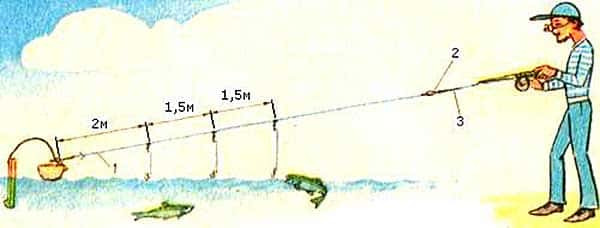
By evenly going downstream, with the help of slight twitching of the reel, you can imitate the fluttering of an insect, which will serve as an additional incentive for the fish to bite. You can also lightly tap the main line with a stick. At the same time, vibration will be transmitted to the bait, circles from it will scatter across the water, which will significantly increase the chance of attracting fish.
Another method is to slightly deepen the fly, carried out by lowering the reel to the water itself, or simulating the take-off of insects when lifting them up. The most preferable is the uniform movement of the boat with the current. In this case, the bait will move in front of the angler, so the sound of footsteps and shadows will not scare the fish.
How to catch grayling in weak currents and still water
When using this method, the boat is launched from the shore below the place where fishing is supposed to be done, and, moving along the shore, the cord gradually unwinds. The ship moves away to the required distance. It should be understood that in this case it will be impossible to stand still, because... the fishing line will definitely sag, and the boat will be brought to the shore.
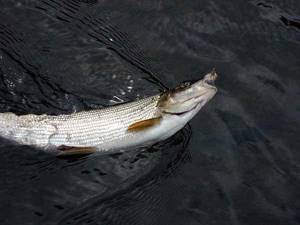
Fishing for grayling in this way requires almost continuous movement along the shore
— Small grayling (up to 15 cm) often attacks the bait “in flight.” You can often see how he misses when jumping out of the water; “ The big one, on the contrary, grabs the bait right from the water, swallowing it deeply, so it’s quite possible to miss the moment of the bite, learning about it only after the fishing line suddenly tightens. In this case, you need to make a sharp cut using a reel to the side or up, and then begin the pulling process. This should be done slowly, trying to raise the fish's head above the surface. This does not always work out, because... The boat is a rather inertial tackle, and part of the energy is transferred to the boat itself. The connection with the fish is not as tight as, for example, when fishing with a spinning rod. When pulling out fish, you need to pay attention to the correct placement of the fishing line on the shore in order to avoid its subsequent tangling.
It is recommended to catch grayling on riffles, in fairly powerful jets of water that are formed due to unevenness of the bottom or a slight narrowing of the banks at the boundary between standing water and current. If a bite occurs, it is recommended to remember this place in order to return here after 20-30 minutes. If it was successful, most likely there is another grayling not far from this place, but if the bite was unsuccessful, it can be repeated. Grayling is a rather cautious fish; even a shadow falling from a fishing line on the water can scare it away. When choosing a fishing location, this point should be taken into account.
General description and application
The operating principle of the boat is the same as that of a water kite. The appropriate shape and specific arrangement of the cord allow this design to cover long distances under the influence of the current or the shore. At the same time, modern fishermen actively use reversible models, which can be set to a specific route of movement.
And although fishing equipment stores are overflowing with all kinds of gear and advanced developments, the classic fishing boat continues to be in demand and is of interest to both experienced fishing fans and beginners. Fishing with such a device is not only interesting, but also exciting. In addition, many men compare the action to a sports competition with special adrenaline and unforgettable emotions.
Currently, the boat can be used for the following purposes :
- If fishing occurs at a long distance using surface baits.
- If fishing is carried out in places with tree branches hanging over the shore.
- If the reservoir is covered with all kinds of algae, and there is no opportunity to use classic spinning baits.
Ships that do not have an engine are effective for bodies of water with current, since there they will be affected by the force of the water flow.
Most homemade designs work like the oldest invention. To understand the principle of operation, it is necessary to take as an example a piece of log 40 cm long and 10 cm in diameter, the ends of which are sharpened, and then two ropes of different lengths are attached to them. In turn, the ropes are tied to each other at one point, perhaps on a ring, after which a working cord with a garland of thin leashes is attached to them. Due to such design features, the mechanism was exposed to the current, and through the efforts of the fisherman it was possible to change course and maneuver.
After successfully hooking the fish, the boat was pulled back to shore using a cord.
Today's fishing fans successfully catch both peaceful and predatory fish with this device. In this case, various baits of artificial or natural origin are used. The main thing is that they are superficial.

